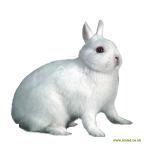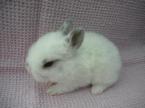|
Why Are Netherland Dwarf Rabbits A Good Pet?
Netherland Dwarf Rabbits have a baby face that you’ll just fall in love with. Even full-grown, these little guys keep a babyish appearance. They have a small compact body weighing only 2 pounds. And their sturdy body makes them a good pet rabbit for adults and children. These curious little creatures do need a lot of daily exercise. So you will need an area where they can hop around safely. Remember to bunny-proof any room your pet rabbit is in. This would be a good time to bond with your rabbit. When he is out exploring, sit in the room so you can make sure he doesn’t get into trouble and he will get to know you better.
It’s been noted that the Netherland Dwarf rabbits origins go back to England as far back as the 1880. These little bunnies are the result when a Polish was crossbred with a small wild rabbit. The first dwarf rabbits were more like wild rabbits. They were fearful and sometimes had aggressive behavior. Through selective breeding throughout the years, today’s Netherland Dwarf rabbit is a gentle, friendly pet. With their round faces, large eyes and short pointed ears, these rabbits retain their baby-like appearance throughout adulthood. Maybe that’s one reason why they are very popular as a pet and show rabbit. In 1965 to improve the Polish breed, fanciers exported the Netherland Dwarfs to the US. A group was then formed to promote and encourage the breeding and showing of this little bunny in the US. The English standard formed the basis and with a few minor changes, the Netherland Dwarf was accepted by the ARBA in 1969. The American Netherland Dwarf rabbit club was granted an ARBA charter in 1970. Today, at the ARBA conventions, the Netherland Dwarf rabbits are among the largest entries. This breed is still growing in popularity.
CARE
The digestive system of the Netherland Dwarf rabbit is very sensitive, even more sensitive than most breeds. So it is important to feed your pet rabbits a proper diet of fresh, good quality pellet food in proper amounts. Fresh pellets, that have been stored no more than eight weeks, pellets free from mold and any other contaminations. It is best to feed your rabbit a pellet that has a high percentage of fiber (18-20%) and low percentage of fat (2-3%) and protein (14-15%). Once you find a good pellet stay with it. Switching brands can upset your rabbit’s digestive system and cause digestive problems. If for some reason you have to change food, do it gradually, over a week’s time. Introduce the new pellet mixed with the current in an 80/20 mixture (80 current/20 new). Then after a few days introduce a 50/50 mixture, then a 20/80 mixture, then a 100 % of the new pellet. This way you rabbit’s digestive system will get use to the new pellet without problems. Be sure not to over feed your dwarf rabbit. The daily amount of pellets to give your rabbit is 2-3 oz. Per day. This amount can be adjusted depending on the adult weight of your rabbit. If you have questions contact your vet. Snacks should be given in small amounts measured in teaspoons; favorable treats are oatmeal, veggies and herbs. Be careful when introducing a new treat, wait 24 hours after the first time to see how well your rabbit tolerated it. If no signs of problems such as loose stool or diarrhea then they should be able to tolerate that treat ok. Just be careful with anything and everything you feed your rabbit.
Fresh water is also a must. Make sure your dwarf rabbit has fresh, clean water available to him at all times. If you choose the bottle or bowl method, make sure your rabbit has clean, fresh water daily.
Rabbits will also involve themselves in coprophagy. This is when they produce small moist droppings that they will ingest. This is normal for rabbits to do; these droppings contain added nutrients for them.
GROOMING
A Netherland Dwarf rabbit does not require much grooming. During the fall and spring when your rabbit will usually have the heaviest shedding (molt), a good wire brush (slicker) will help remove all excess fur. Another good reason to brush your rabbit is to remove loose fur so when your rabbit grooms himself, he will not ingest a lot of fur that can cause hairballs.
Your rabbit does not need to be bathed. As a matter of fact, they probably will not like it at all. Rabbits are like cats when it comes to bathing. Rabbits continuously groom themselves, so a bath is not needed. It may also be too stressful to them if you try to give them a bath. If your rabbit is dirty, just use a wet cloth to clean the area that’s soiled.
I had to clean the back-end of Foo when he was sick so I would just put his back-end in water to clean him. Your local pet store will carry rabbit shampoo but I never gave any of my boys a full bath. I would just clean the area that was very soiled when they were sick. Now that I know what caused their sickness, Oreo does not have any problems. Rabbits also need their nails trimmed. If you do not feel secure cutting your rabbits nails, you can always make an appointment at your vet’s and they will trim his nails. It is not difficult to trim the nails; you just have to be careful. If you are not you might cut into the quick and then the nail will bleed. There is medicine you can buy to apply to the nail to stop the bleeding. To see the quick (vein in nail) in a rabbit’s nail, shine a light under the nail. You should be able to see where the quick ends. Cut the nail approx. 1/8” before the quick.
Most of the dwarfs you see in pet stores will be a Netherland Dwarf rabbit. They have a friendly temperament and are curious little creatures that make you fall in love with them. A purebred comes in many colors to choose from; Blue-Eyed White, Ruby-Eyed White, Himalayan, Black, Blue, Chocolate, Lilac, Smoke, Pearl, Sable Point, Tortoiseshell, Chestnut, Siamese Sable, Opal, Lynx, Squirrel, Chinchilla, Otter, Tan, Silver Marten, Sable Marten, Smoke Pearl Marten, Orange, Fawn, Steel and Broken.
These dwarf rabbits that weigh at maximum weight of 2 pounds are growing in popularity as a pet and show rabbit. This breed with their baby-like features is a real crowd pleasure. Just look how cute these little guys are!
Keep your rabbit happy and safe. Check this out.......
|






